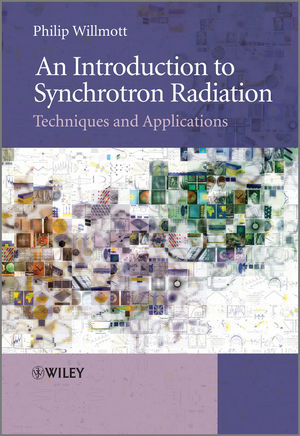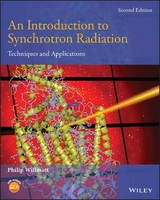
An Introduction to Synchrotron Radiation
Wiley-Blackwell (Verlag)
978-0-470-74578-6 (ISBN)
- Titel gebraucht verfügbar
- Artikel merken
This book introduces the reader to the basic concepts of the generation and manipulation of synchrotron light, its interaction with matter, and the application of synchrotron light in the classical techniques, while including some of the most modern technological developments. As much as possible, complicated mathematical derivations and formulas are avoided. A more heuristic approach is adopted, whereby the general physical reasoning behind the equations is highlighted. Key features: * A general introduction to synchrotron radiation and experimental techniques using synchrotron radiation * Contains many detailed worked examples from the literature * Of interest for a broad audience - synchrotrons are possibly one of the best examples of multidisciplinary research * Four-colour presentation throughout
Philip Willmott is a physicist with over 25 years' experience in diverse aspects of experimental physics and materials science. He was based at the Physical Chemistry Institute of Zurich University between 1995 and 2001, researching in surface science and teaching undergraduate courses in physical chemistry. He has been teaching elective courses in surface science, laser physics, and introductory courses in synchrotron physics and techniques since 2001 and has been a titular professor in the Physics Institute of Zurich University since 2009. He became the Beamline Manager at the Materials Science beamline of the Swiss Light Source at the Paul Scherrer Institut in 2007.
Preface xiii Acknowledgements xv 1. Introduction 1 1.1 A Potted History of X-rays 5 1.2 Synchrotron Sources Over the Last 50 Years 10 References 14 2. The Interaction of X-rays with Matter 15 2.1 Introduction 15 2.2 The Electromagnetic Spectrum 16 2.3 Thomson Scattering 19 2.4 Compton Scattering 20 2.5 Atomic Scattering Factors 21 2.5.1 Scattering From a Cloud of Free Electrons 21 2.5.2 Correction Terms for the Atomic Scattering Factor 22 2.6 The Refractive Index, Reflection and Absorption 25 2.6.1 The Refractive Index 25 2.6.2 Refraction and Reflection 25 2.6.3 Absorption 28 2.7 X-ray Fluorescence and Auger Emission 32 2.7.1 X-ray Fluorescence 33 2.7.2 Auger Emission 35 2.7.3 Fluorescence or Auger? 36 2.8 Concluding Remarks 37 References 37 3. Synchrotron Physics 39 3.1 Introduction 39 3.2 Overview 39 3.3 Radiation From Relativistic Electrons 43 3.3.1 Magnetic Deflection Fields 46 3.3.2 Radiated Power Loss in Synchrotrons 47 3.4 Radio Frequency Power Supply and Bunching 48 3.5 Photon Beam Properties 50 3.5.1 Flux and Brilliance 50 3.5.2 Emittance 51 3.5.3 Coherence 53 3.5.4 Polarization of Synchrotron Radiation 54 3.6 Bending Magnets and Superbends 55 3.7 Insertion Devices 57 3.7.1 Wigglers 58 3.7.2 Worked Example: The SLS Materials Science Beamline Wiggler 60 3.7.3 Undulators 60 3.8 Future Sources of Synchrotron Light 68 3.8.1 The Energy Recovery Linac 68 3.8.2 The Free-Electron Laser 70 3.8.3 Tabletop Synchrotrons 81 3.9 Concluding Remarks 85 References 85 4. Beamlines 87 4.1 Introduction 87 4.2 Front End 87 4.2.1 Beam-Position Monitors 88 4.2.2 Primary Aperture and Front-End Slits 89 4.2.3 Low-Energy Filters 90 4.3 Primary Optics 91 4.3.1 X-ray Mirrors 91 4.3.2 Mirror Focal Lengths The Coddington Equations 94 4.3.3 Monochromators 95 4.3.4 Focusing Geometry 105 4.4 Microfocus and Nanofocus Optics 106 4.4.1 Lens Types 107 4.5 Beam Intensity Monitors 112 4.6 Detectors 113 4.6.1 Photographic Plates 113 4.6.2 Scintillator Detectors 114 4.6.3 The Point-Spread Function 115 4.6.4 Crystal Analysers 116 4.6.5 Image Plates and Charge-Coupled Devices 118 4.6.6 Pixel and Microstrip Detectors 119 4.6.7 Energy-Dispersive Detectors 123 4.7 Time-Resolved Experiments 127 4.7.1 Avalanche Photodiodes 128 4.7.2 Streak Cameras 128 4.8 Concluding Remarks 129 References 130 5. Scattering Techniques 133 5.1 Introduction 133 5.2 Diffraction at Synchrotron Sources 134 5.3 Description of Crystals 136 5.3.1 Lattices and Bases 136 5.3.2 Crystal Planes 137 5.3.3 Labelling Crystallographic Planes and Axes 140 5.4 Basic Tenets of X-ray Diffraction 140 5.4.1 Introduction 140 5.4.2 The Bragg Law and the Reciprocal Lattice 143 5.4.3 The Influence of the Basis 146 5.4.4 Kinematical and Dynamical Diffraction 147 5.5 Diffraction and the Convolution Theorem 147 5.5.1 The Convolution Theorem 148 5.5.2 Understanding the Structure Factor 149 5.6 The Phase Problem and Anomalous Diffraction 149 5.6.1 Introduction 149 5.6.2 The Patterson Map 151 5.6.3 Friedel s Law and Bijvoet Mates 152 5.6.4 Anomalous Diffraction 153 5.6.5 Direct Methods 156 5.7 Types of Crystalline Samples 159 5.8 Single Crystal Diffraction 161 5.8.1 Laue Diffraction 161 5.8.2 Single Crystal Diffraction With Monochromatic X-rays 165 5.9 Textured Samples 168 5.9.1 Worked Example Microdiffraction of Ancient Textiles 168 5.10 Powder Diffraction 171 5.10.1 Introduction 171 5.10.2 Basics of Powder Diffraction 172 5.10.3 Worked Example Structural Solutions Made Easy 173 5.10.4 The Pair-Distribution Function 175 5.11 Protein Crystallography 176 5.11.1 Introduction 176 5.11.2 Geometry and Resolution 177 5.11.3 Solving the Phase Problem in PX 179 5.11.4 Worked Example Cracking the Rabies Virus Protection Shield 182 5.11.5 Protein Powder Diffraction 183 5.11.6 Time-Resolved Studies 184 5.12 Ultrafast Diffraction Using Femtoslicing 186 5.13 Surface Diffraction 188 5.13.1 Introduction 188 5.13.2 Crystal Truncation Rods 190 5.13.3 Superstructure Rods 192 5.13.4 Data Acquisition 194 5.13.5 Worked Example The Surface of Strontium Titanate 195 5.14 Resonant X-ray Diffraction 196 5.15 X-ray Reflectometry 198 5.15.1 Introduction 198 5.15.2 Reflection of X-rays and the Fresnel Equations 199 5.15.3 Thin Films and Multilayers 202 5.15.4 Worked Example Monitoring Monolayer-for-Monolayer Thin Film Growth 206 5.16 Small-Angle X-ray Scattering 208 5.16.1 Introduction 208 5.16.2 Theory 208 5.16.3 Practical Considerations 214 5.16.4 Worked Example The Shape of Memory 215 5.16.5 Grazing-Incidence SAXS 217 5.17 Concluding Remarks 218 References 219 6. Spectroscopic Techniques 223 6.1 Introduction 223 6.2 X-ray Absorption Processes 224 6.2.1 Energy Level Schemes of Atoms, Molecules and Solids 226 6.2.2 Absorption Features 229 6.3 Photoelectron Energies, Wavelengths and Absorption Regions 231 6.4 X-ray Absorption Near-Edge Structure, XANES 233 6.4.1 Introduction 233 6.4.2 The XANES Signal 234 6.4.3 Worked Example Preservation of the Seventeenth-Century Warship Vasa 238 6.5 Extended X-ray Absorption Fine Structure, EXAFS 240 6.5.1 Introduction 240 6.5.2 The EXAFS Signal 241 6.5.3 Worked Example Resistance of Lichens to Metallic Pollution 245 6.5.4 Time-Resolved Absorption Spectroscopy 247 6.6 Fluorescence Spectroscopies 249 6.6.1 Introduction 249 6.6.2 X-ray Fluorescence 250 6.6.3 Resonant Inelastic X-ray Scattering 252 6.6.4 X-ray Standing Waves 258 6.7 Scanning Transmission X-ray Microscopy, STXM 259 6.7.1 Introduction 259 6.7.2 The Water Window 260 6.7.3 Modes in STXM 261 6.7.4 Worked Example Extraterrestrial Origins of Life 262 6.8 Photoemission Electron Microscopy 265 6.8.1 Basics of PEEM 265 6.8.2 Worked Example The Sea Urchin s Tooth 267 6.8.3 PEEM and Magnetic Dichroism 269 6.9 Photoemission Spectroscopy 273 6.9.1 Introduction 273 6.9.2 Ultraviolet Photoemission Spectroscopy 276 6.9.3 X-ray Photoelectron Spectroscopy 289 6.10 Concluding Remarks 297 References 297 7. Imaging Techniques 303 7.1 Introduction 303 7.2 Computed Microtomography 304 7.2.1 Introduction 304 7.2.2 General Concepts 306 7.2.3 Practical Considerations 310 7.2.4 Phase-Contrast Tomography 311 7.2.5 Soft X-ray Tomography 320 7.2.6 Worked Example The Spread of Hominoids 322 7.3 Lensless Imaging 326 7.3.1 Introduction 326 7.3.2 Speckle 328 7.3.3 Noncrystalline and Crystalline Samples 329 7.3.4 Ptychography 331 7.3.5 X-ray Photon Correlation Spectroscopy 333 7.4 Concluding Remarks 334 References 335 Appendix: Physical Constants Relevant to Synchrotron Radiation 339 Index 341
| Verlagsort | Hoboken |
|---|---|
| Sprache | englisch |
| Maße | 172 x 240 mm |
| Gewicht | 686 g |
| Themenwelt | Naturwissenschaften ► Chemie |
| Naturwissenschaften ► Physik / Astronomie ► Atom- / Kern- / Molekularphysik | |
| Naturwissenschaften ► Physik / Astronomie ► Hochenergiephysik / Teilchenphysik | |
| ISBN-10 | 0-470-74578-9 / 0470745789 |
| ISBN-13 | 978-0-470-74578-6 / 9780470745786 |
| Zustand | Neuware |
| Haben Sie eine Frage zum Produkt? |
aus dem Bereich




